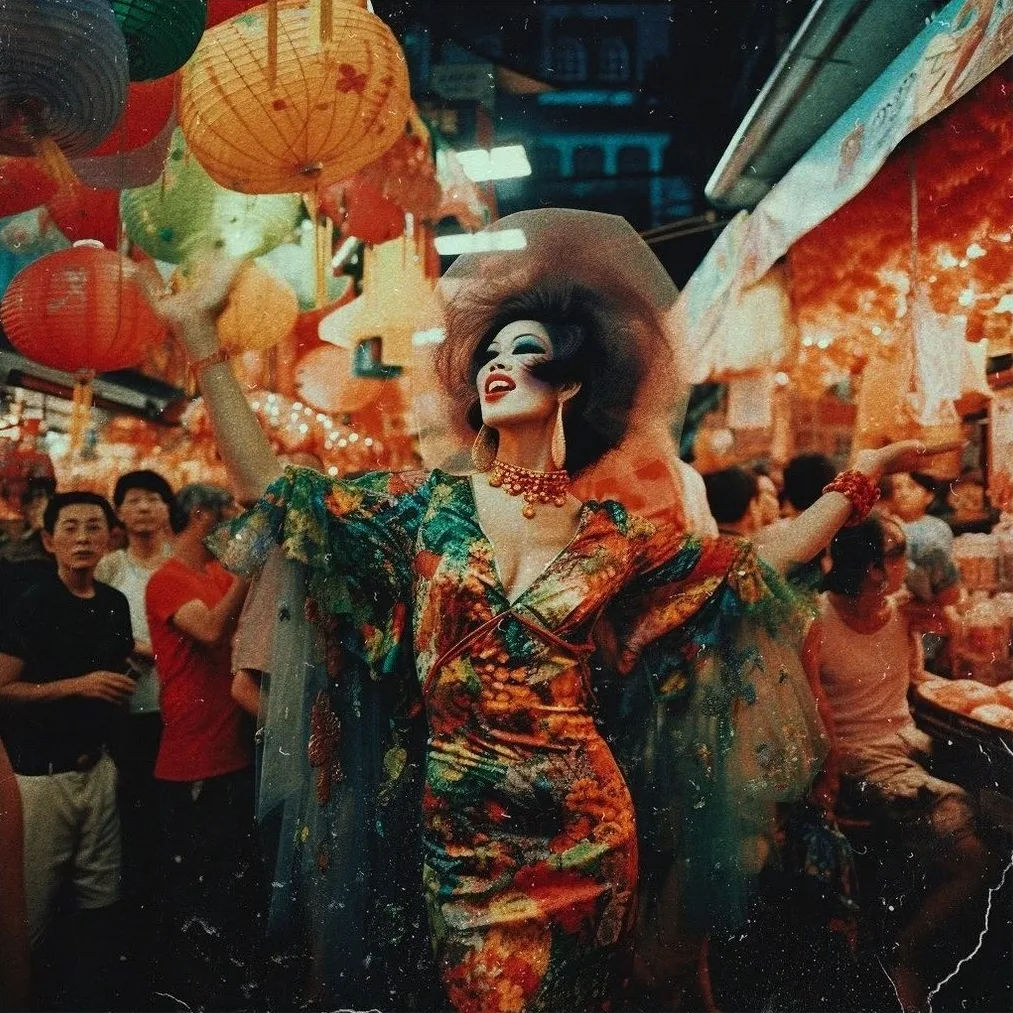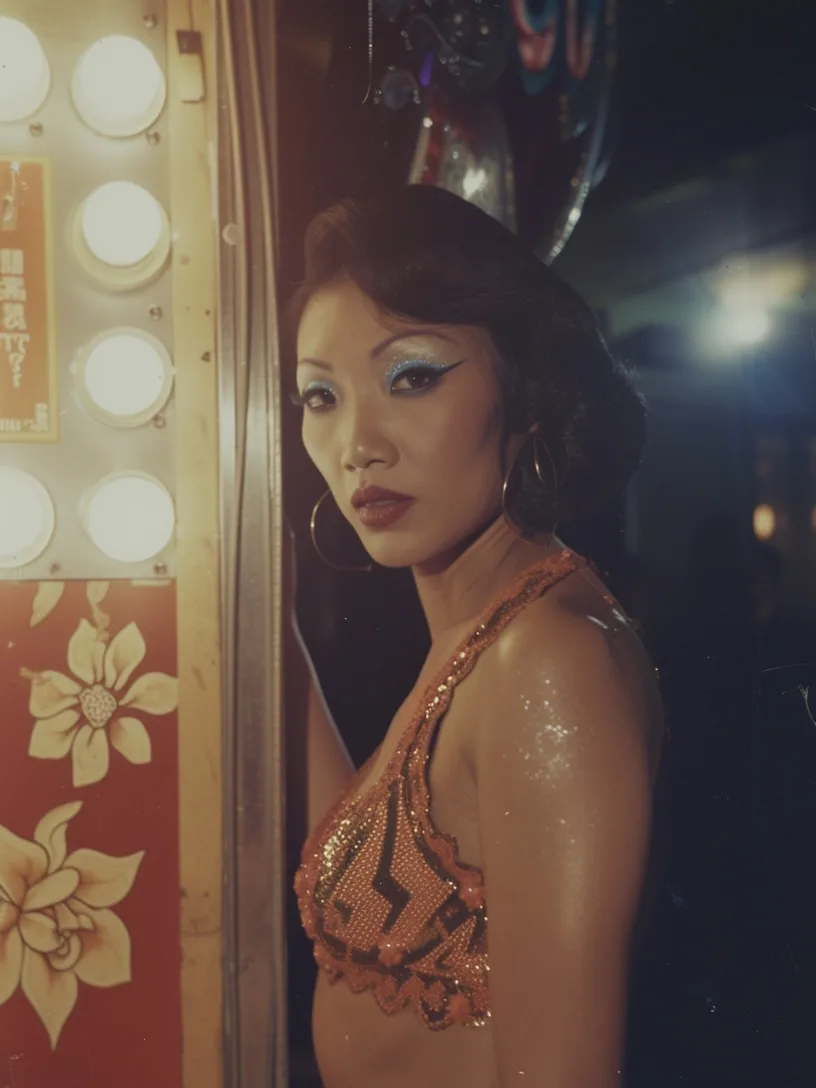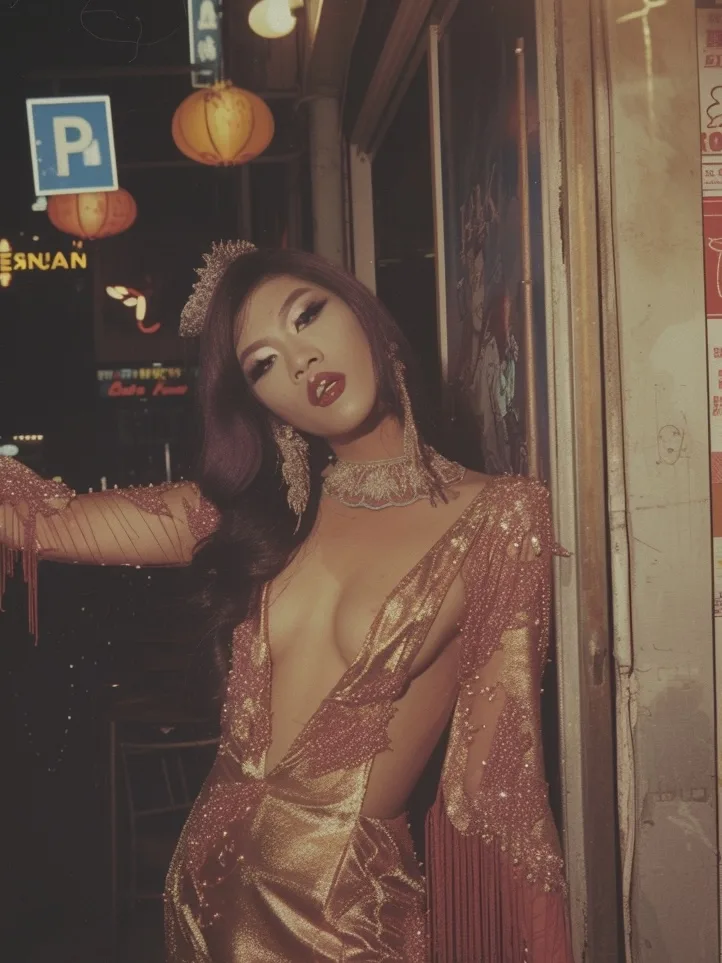

Glamorous women parading through an avenue of vegetable sellers and street food carts, their shimmering make-up and sequined costumes glinting in the ambient light from neon bulbs and paper lanterns. Welcome to 1970s Bugis Street, Singapore, remembered in all its vivid glory—with the help of AI—by photographer AikBeng Chia, who saw it with his own eyes as a child. He tells Alix-Rose Cowie how AI has added a new dimension to his work, and why he still thinks about the people he saw on Bugis Street to this day.
AikBeng Chia is a photographer well-known for his shots of street life in Singapore, capturing moments overlooked by others that he can’t help but notice. His latest series is set in gritty Bugis Street, and it’s filled with vibrant nightlife, but if you took a cab to Bugis Street right now, you’d find a glass-domed mall—part indoor department store and air-conditioned pedestrian shopping street complete with Starbucks and McDonald’s. Even on weekends, the crowds have dispersed long before midnight.


Chia is not a time traveler, but his project “Return to Bugis Street” is set in the 1970s, when the then-notorious haunt was animated by nocturnal revelers and those needing steaming street food the next day. It was made using artificial intelligence tool Midjourney, based on childhood memories of trips there with his father. “I remember being intrigued by the colorful characters that filled the street night and day,” he says. To him the captivating drag queens and trans sex workers in their dresses, high heels and boldly-painted faces were like something out of a fairytale. “Of course, at the time, I was too young to understand what was really going on. Now, after 53 years, I find myself looking back on those memories with curiosity. I can’t help but wonder what might have become of those people I saw so long ago. What was it like for them, living in a society that didn’t always accept them?”
Chia’s curious nature led to his experiments with AI. “I saw it as a tool with huge potential to help me create images in ways I hadn’t been able to before,” he says. “What got me hooked was seeing the results—the way AI transformed my images, added new dimensions to my work and inspired me to think outside the box. It opened up a whole new world of possibilities.”
Though a completely different medium, it’s important that Chia’s AI creations still feel like his photographs: recognizable as his ideas, connected by his artistic vision and not alienating to fans of his photography. The style of his Bugis Street series was intentionally based on street photography, a significant part of his practice. The images have the feeling of spontaneous captures illuminated as if with natural or available light. In AI-assisted “photographs,” achieving this can be tricky. To simulate the atmospheric lighting of 1970s Singapore, he used a combination of AI tools and manual adjustments to tweak the direction, intensity and color temperature of the light.
Chia’s digital reconstructions start on paper by pre-planning the subjects’ poses, the framing of the shot and the camera angles in sketches or moodboards before writing any prompts. Communication has to be clear when your collaborator’s next move is uncertain. “I have a fair amount of control over the process in terms of setting parameters and guiding the AI towards the desired outcome,” Chia says. “However, there are limitations, such as the AI’s interpretation of my inputs and the occasional unpredictability of the results.” It can take several attempts and fine-tuning to get the images close to what he imagined. “The AI sometimes interprets my inputs in unexpected ways that are different from my initial vision, but still intriguing and valuable in their own right.”


Predating his work as a photographer, Chia has had a long career as an art director. The skill to envision a scene is advantageous when adding all the details that reinforce the story. For this project, he fed each of his memories into Midjourney: the plastic chairs that drinkers and diners sit on in the street, the surrounding architecture matching the era, the heaped plates of noodles or fried rice and the condiments on the melamine table-tops. For the fashion prompt, he looked at historical photographs to research the trends on full display on the strip: bold colors, patterns and unique silhouettes finished with feathers, blue eyeshadow and blonde wigs. After generating the images in Midjourney, Chia added film grain and adjusted the color grading, contrast and saturation in post-production for a vintage look. “By making the images resemble film photographs, I aimed to transport viewers back in time through a visual connection to the era.”

These characters represent a vibrant and unique aspect of Singapore’s history.
Half a century ago, Chia stood on this street and witnessed these scenes. In a way, his project is a documentary, or memoir. However it’s defined, it’s an interesting study in genre. “I see AI projects as sitting at a fascinating intersection between documentary, preserving memories and pure fantasy,” he says. “They offer a unique space where reality and imagination can blend, creating a new form of storytelling. While traditional documentary photography focuses on capturing real moments and preserving memories, AI allows for the addition of creative layers that can enhance or transform these moments into something more fantastical or abstract.” His explorations with AI have expanded his idea of himself as a photographer. “It’s broadened my perspective on what photography can be and how it can be created.”
In 1985, bulldozers were sent to demolish the stalls of Bugis Street. The people who made it what it was were forced to find business elsewhere. “The characters in the Bugis Street project hold a special significance to me as they represent a vibrant and unique aspect of Singapore's history,” Chia says. “I wanted to capture their humanity and the complexities of their experiences. By depicting them with empathy and respect, I aimed to honor their legacy and contribute to a more inclusive understanding of the past.”




